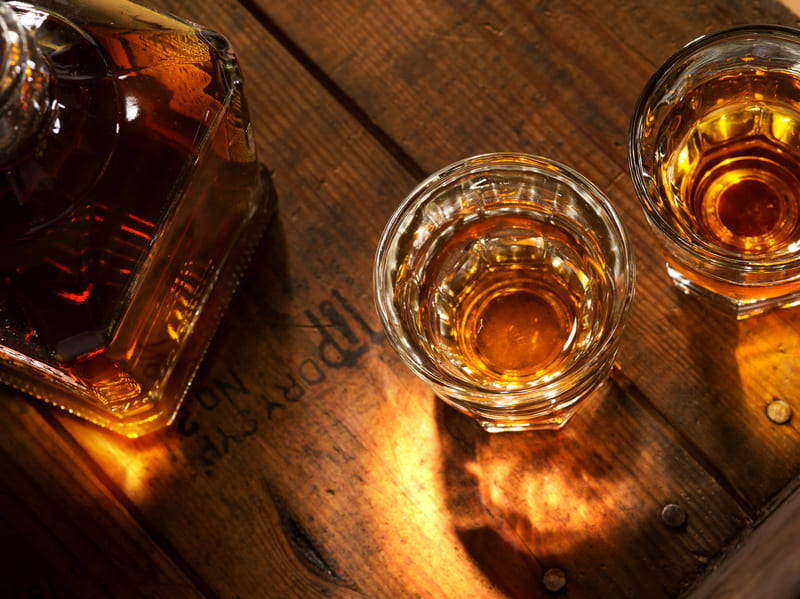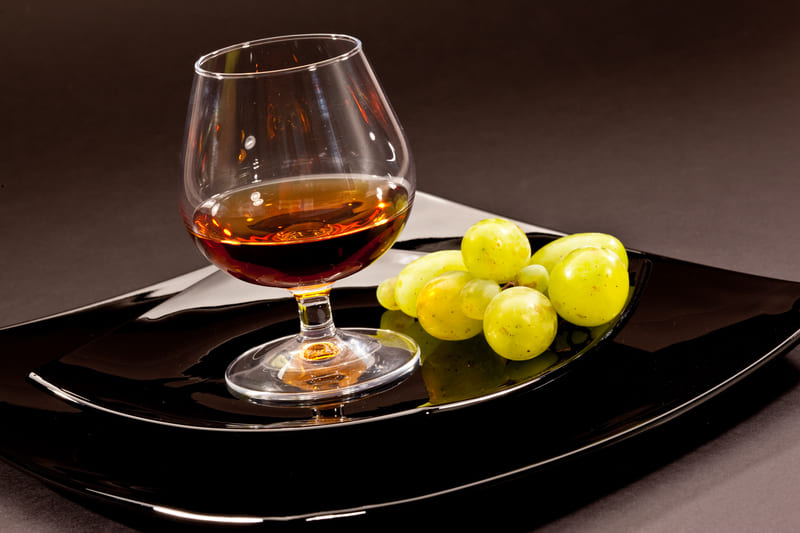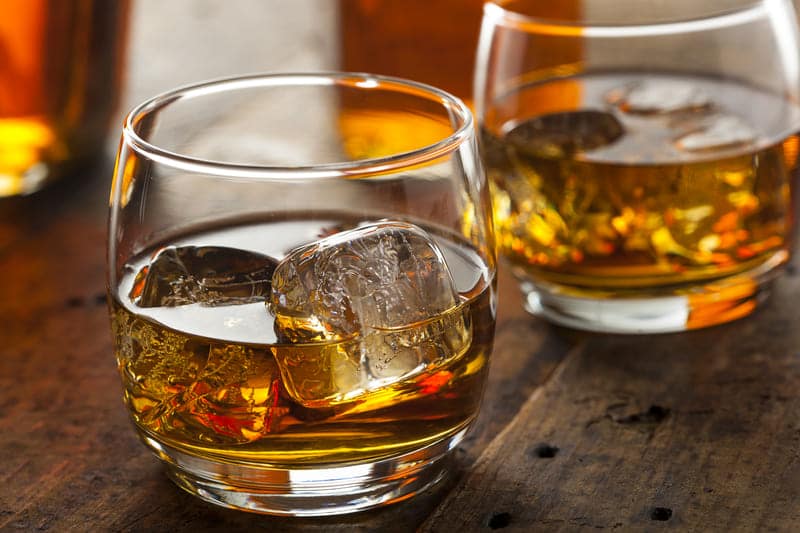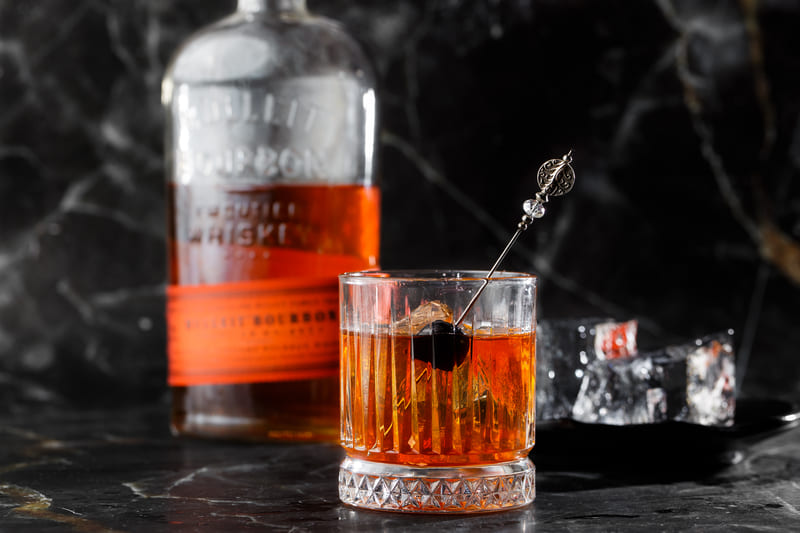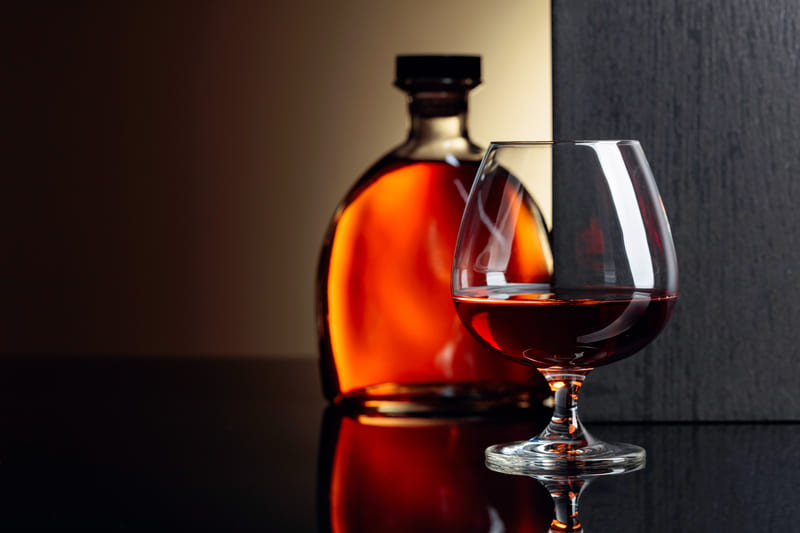Beloved by many and having fans worldwide, brandy and whiskey are probably the most popular and best-known alcoholic drinks worldwide.
If you haven’t tried them, chances are, you know of them and maybe know something about them. Whether you are a whiskey or brandy lover or not, these two drinks are always a welcomed subject of discussion as there is a lot to say about them.
Due to the similar appearance and branding, whiskey and brandy are often considered to be a variation of the same drink, while, in fact, they are two entirely different alcoholic products.
Because both of them are made by distilling and need to age before drinking/selling, brandy and whiskey are bound to have some similarities. However, they still remain separate as those similarities aren’t as significant as the key differences between them.
Brandy is, essentially, distilled wine, and whiskey is made by distilling grains and corn. They both need to age, whereby whiskey needs to age at least five years, while brandy ages at least two. Whiskey can be traced back to 15th-century Scotland, and brandy originated in the 15th century in Italy. Brandy tastes fruity and sweet with a noticeable floral aroma, while whiskey is a shaper, mixing caramel, oak, honey, and smoky flavor notes.
Brandy and whiskey are both superb drinks, and if we’re talking about good quality brands, both can bring you immense pleasure and satisfaction. However, suppose you are inexperienced in the alcohol department, or at least in the whiskey and brandy department. In that case, you may find it hard to appreciate these drinks due to a lack of information.
If you don’t enjoy whiskey, it may not be the whiskey’s fault, but rather the fact that you don’t like whiskey in general, and the same goes for brandy too. So, in the following article, I will discuss the differences between whiskey and brandy so that you can find out more about these drinks and choose the one you genuinely enjoy.
What Is Brandy?
In essence, brandy is a distilled wine that needs to age at least two years to be considered mature. It has a characteristic dark red-brown color which can be obtained through the maturing process or by using caramel-flavored colorings. Some brandy producers combine both the coloring and the maturation process to give the brandy its signature deep and rich dark red-brown color.
Since brandy is distilled wine, it tends to have a fruity flavor and a floral aroma, with notes of vanilla and caramel, which it acquires during maturation. Brandy is intended to use as a post-meal digestif, as it is known to help digestion, but you can also have a glass just for pleasure combined with some toasted nuts and citrus fruits. In addition to helping digestion, brandy has little to no proven health benefits.
Brandy is a typically gentle drink, with no excessive burn, though you will definitely notice it going through your throat. This, of course, applies to the higher-end brandy brands; the lower-quality brandy tends to be more aggressive with an unnecessary burn.
Therefore there are coke and brandy mixtures that are common for the lower-quality brandies to sweeten up the taste and tone down the burn and sharpness.
The most famous brandy types are Cognac and Armagnac, which also vary in quality and price. The ones with better quality are fruity and smooth, while the cheaper ones are noticeably harsh with an expressive ethanol aroma.
Also Check: 25 Best Whiskey for Old Fashioned
What Is Whiskey?
Whiskey is a spirit made by distilling grains that are often malted. The whiskey grain mash often includes barley, corn, rye, and wheat.
Whiskey has a dark brown, honey-like color that sometimes resembles chocolate and is highly seductive and inviting. It needs to age for at least five years and it usually ages in charred white oak casks. Often, the whiskey is left to mature in uncharred white oak casks used to mature sherry, which is why sometimes whiskey has a fruity and sweet cherry note.
Usually, whiskey tends to taste like caramel, honey, and chocolate with a noticeable smoky note and a whiff of vanilla. It is noticeably stronger than brandy, and it burns considerably more. However, whiskey is an incredibly smooth drink and an excellent digestif.
Whiskey has a strong aroma and a particular taste, and even if you’ve had it once, you will know if you have it again. Whiskey is a highly regulated spirit, meaning that each whiskey brand has to adhere to certain regulations. Therefore, even the cheapest, lowest quality whiskey brands meet the minimum whiskey standards and regulations.
The cheaper and lower-quality whiskey brands are brighter in color and much more aggressive than the high-quality, smooth whiskeys, but they still have the recognizable caramel and smoky whiff of the whiskey.
| Brandy | Whiskey |
| Distilled wine | Distilled grain mix |
| Fruity flavor with a floral aroma | Honey and caramel flavor, with a whiff of vanilla and oak |
| Gentle and smooth | Smooth but sharper than brandy |
| Digestif | Digestif |
| Dark red-brown color | Dark honey-brown color |
| Ages for a minimum of two years | Ages for a minimum of five years |
Differences between Brandy and Whiskey
Although they share the same production method- distilling and age before consumption, brandy and whiskey are two different alcoholic drinks. In spite of the similarities between them, there are some key differences that are significant enough to define them as two different beverages.
Origin
Both whiskey and brandy originated in the 15th century. Whiskey is deemed to have originated in Scotland and brandy in Italy.
Both have very interesting histories and are probably some of the best inventions in the history of alcohol.
Brandy was never intended to be a separate drink, as the makers intended to prolong the life of the wine by distilling it, which made it easier to transport. The original idea was to distill the wine, transport it and revert it back to wine.
However, since distillation was still in the experimenting stages in Italy back then, they had no idea what the wine would taste like after the distillation process, and therefore they invented a new spectacular drink without even trying.
After seeing that brandy is an exquisite beverage, the wine producers started experimenting with different wines, in addition to distilling grape wine, and saw that the results were even more awesome. So, today, different kinds of brandy are made with different kinds of fruit.
Whiskey was initially intended and used as a medicine for internal and external disinfection and as an anesthetic. The distilling process appeared in Ireland between the 12th and the 14th century, and it was brought there by the monks who started distilling barley beer.
Until the 15th century, distilling was a process that was limited to monks and apothecaries because the distilled drinks were mainly used as medicines. In the 15th the Irish started immigrating to America and took the whiskey recipe with them which is when the whiskey we today know and love was created.
Making and Ingredients
Both brandy and whiskey are obtained through distilling. Brandy is obtained through distilling wine and whiskey through distilling grain mash, usually composed of rye, barley, wheat, and corn that may or may not be malted.
The making of brandy consists of three stages: fermentation, distillation, and aging. The fermentation is the initial step in brandy-making, and it is necessary to obtain the wine base. In addition to grapes, the fermentation process can include apples, blackberries, peaches, pears, and apricots.
Depending on which fruit has been used during fermentation, the wine base will taste differently, making the brandy a very versatile drink.
After the fermentation process is complete, the wine base is then distilled to obtain a higher amount of alcohol. After distilling, the liquid is poured into charred white oak casks and left to mature for at least two years. Sometimes, uncharred white oak casks are used to mature the brandy.
Also Check: Bourbon vs Whiskey vs Scotch
These casks are usually used for sherry, which is why the brandies aged in these casks have a distinct fruity aroma and flavor.
Whiskey also encompasses the same three production stages of the brandy production process. It starts like beer by fermenting a grain mash with added yeast. The grain mash usually consists of barley, wheat, rye, and corn. Sometimes the grains are malted, but they don’t have to be.
The fermented grain mash is then distilled, during which process the sugar from the grains turns into alcohol, and the distillate is higher in alcohol content. Lastly, the distillate is left to age for a minimum of five years in oak barrels, during which process it acquires the recognizable hone-brown color and the velvet smoothness.
Taste
Proper whiskey and proper brandy taste heavenly. Brandy has an expressive fruity flavor, a floral aroma, and sometimes a whiff of vanilla and caramel. The longer it ages, the more oak there is in the flavor and the smoother the drink becomes.
Depending on what has been used in the making process, brandy can taste like grapes, apricots, pears, apples, barriers, or a combination of several fruits. Depending on where the fruits have been grown, the brandy can acquire the aroma and taste of the surroundings making this drink extremely rich and versatile.
Whiskey has a recognizable sharpness intertwined with the oak flavor from the barrels and honey and toasted rye notes. It is velvety smooth with a warm burn and a very potent aftertaste.
Ageing Process
The aging process is an integral part of whiskey and brandy production. The longer they age, the smoother and the richer they become. The minimum aging period for brandy is two years, while the least the whiskey needs to age is five years.
Brandy ages in uncharred white oak casks but can also age in charred white oak casks used to age sherry.
Whiskey ages in wood barrels, and the aging process is crucial in whiskey production. Whiskey ages from five to 20 years.
Varieties
Both brandy and whiskey have wide varieties. Irish whiskey, Canadian whiskey, and Scotch are among the most popular whiskey varieties, along with bourbon, which is an entire philosophy in itself.
Among the most famous brandy varieties are Cognac, Armagnac, Armenian brandy, Pisco brandy, etc.
What Is Better Brandy or Whiskey?
Whether you choose to have brandy or whiskey depends on your personal preference and taste. Whiskey and brandy are both exquisite beverages made for pleasure and enjoyment. To say that one is superior to the other would be entirely inaccurate and offensive.
If you are a fan of the more intense and edgier tastes, you should definitely go for the whiskey. If, on the other hand, you like gentler and fruitier flavors, you should go for the brandy.
How Is Brandy Different from Whiskey?
Brandy and whiskey are made of different ingredients but use the same processes’ fermenting, distilling, and aging. While brandy is made of fermented wine, which is then distilled and aged, whiskey is made of a grain mash, often consisting of rye, barley, wheat, and corn.
As a result of the different starter materials, brandy and whiskey taste different. Whiskey has a honey, caramel, and smoky flavor, while brandy has a fruity flavor, often grapes, apples, pears, berries, or peaches, and a floral whiff depending on where the fruit has grown.
Brandy has a dark, deep, and rich red-brown color, while whiskey has a honey-brown shade. Both are incredibly inviting and extraordinarily seductive.
Is Brandy Sweeter than Whiskey?
Generally, brandy is milder, gentler, and sweeter than whiskey. However, this applies only to same-category drinks, meaning you cannot compare cheaper brandy with a more expensive whiskey and conclude that the whiskey is sweeter.
A good quality brandy is sweeter than a good quality whiskey. Though there are some types of brandy that are more on the sour side, still the sweetness is more noticeable than in the whiskey.
The whiskey is generally sharper and more aggressive than brandy.
Resources:
- https://en.wikipedia.org/wiki/Brandy
- https://en.wikipedia.org/wiki/Whisky
- https://www.thespruceeats.com/best-cheap-whiskeys-4154021
- https://www.thespruceeats.com/history-of-whisky-1807685#:~:text=Whiskey%20was%20originally%20used%20as,a%20liquor%20which%20became%20whiskey.
- https://www.tasteofhome.com/article/types-of-whiskey/

